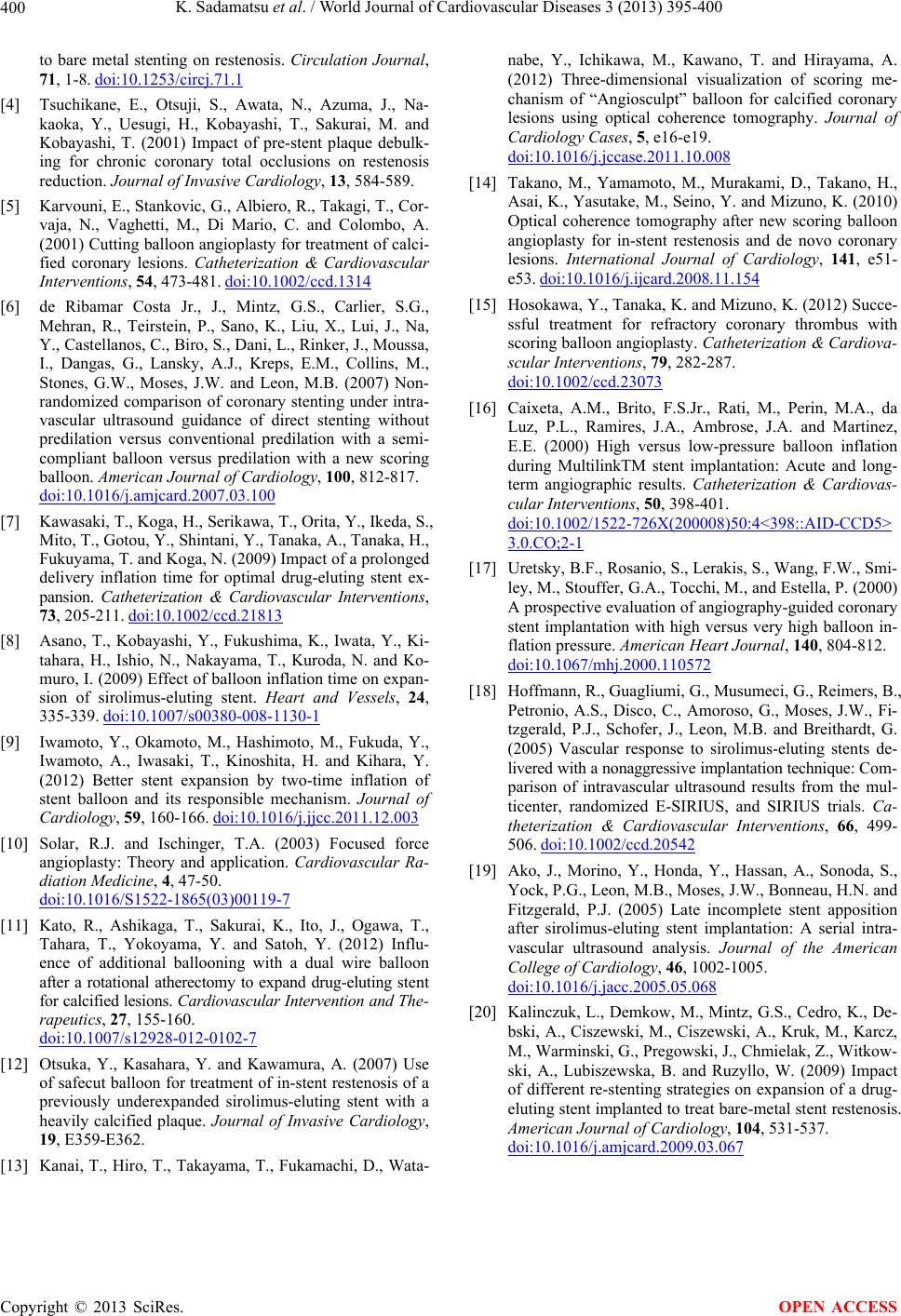
K. Sadamatsu et al. / World Journal of Cardiovascular Diseases 3 (2013) 395-400
Copyright © 2013 SciRes.
400
OPEN ACCESS
to bare metal stenting on restenosis. Circulation Journal,
71, 1-8. doi:10.1253/circj.71.1
[4] Tsuchikane, E., Otsuji, S., Awata, N., Azuma, J., Na-
kaoka, Y., Uesugi, H., Kobayashi, T., Sakurai, M. and
Kobayashi, T. (2001) Impact of pre-stent plaque debulk-
ing for chronic coronary total occlusions on restenosis
reduction. Journal of Invasive Cardiology, 13, 584-589.
[5] Karvouni, E., Stankovic, G., Albiero, R., Takagi, T., Cor-
vaja, N., Vaghetti, M., Di Mario, C. and Colombo, A.
(2001) Cutting balloon angioplasty for treatment of calci-
fied coronary lesions. Catheterization & Cardiovascular
Interventions, 54, 473-481. doi:10.1002/ccd.1314
[6] de Ribamar Costa Jr., J., Mintz, G.S., Carlier, S.G.,
Mehran, R., Teirstein, P., Sano, K., Liu, X., Lui, J., Na,
Y., Castellanos, C., Biro, S., Dani, L., Rinker, J., Moussa,
I., Dangas, G., Lansky, A.J., Kreps, E.M., Collins, M.,
Stones, G.W., Moses, J.W. and Leon, M.B. (2007) Non-
randomized comparison of coronary stenting under intra-
vascular ultrasound guidance of direct stenting without
predilation versus conventional predilation with a semi-
compliant balloon versus predilation with a new scoring
balloon. American Journal of Cardiology, 100, 812-817.
doi:10.1016/j.amjcard.2007.03.100
[7] Kawasaki, T., Koga, H., Serikawa, T., Orita, Y., Ikeda, S.,
Mito, T., Gotou, Y., Shintani, Y., Tanaka, A., Tanaka, H.,
Fukuyama, T. and Koga, N. (2009) Impact of a prolonged
delivery inflation time for optimal drug-eluting stent ex-
pansion. Catheterization & Cardiovascular Interventions,
73, 205-211. doi:10.1002/ccd.21813
[8] Asano, T., Kobayashi, Y., Fukushima, K., Iwata, Y., Ki-
tahara, H., Ishio, N., Nakayama, T., Kuroda, N. and Ko-
muro, I. (2009) Effect of balloon inflation time on expan-
sion of sirolimus-eluting stent. Heart and Vessels, 24,
335-339. doi:10.1007/s00380-008-1130-1
[9] Iwamoto, Y., Okamoto, M., Hashimoto, M., Fukuda, Y.,
Iwamoto, A., Iwasaki, T., Kinoshita, H. and Kihara, Y.
(2012) Better stent expansion by two-time inflation of
stent balloon and its responsible mechanism. Journal of
Cardiology, 59, 160-166. doi:10.1016/j.jjcc.2011.12.003
[10] Solar, R.J. and Ischinger, T.A. (2003) Focused force
angioplasty: Theory and application. Cardiovascular Ra-
diation Medicine, 4, 47-50.
doi:10.1016/S1522-1865(03)00119-7
[11] Kato, R., Ashikaga, T., Sakurai, K., Ito, J., Ogawa, T.,
Tahara, T., Yokoyama, Y. and Satoh, Y. (2012) Influ-
ence of additional ballooning with a dual wire balloon
after a rotational atherectomy to expand drug-eluting stent
for calcified lesions. Cardiovascular Interve ntion and Th e-
rapeutics, 27, 155-160.
doi:10.1007/s12928-012-0102-7
[12] Otsuka, Y., Kasahara, Y. and Kawamura, A. (2007) Use
of safecut balloon for treatment of in-stent restenosis of a
previously underexpanded sirolimus-eluting stent with a
heavily calcified plaque. Journal of Invasive Cardiology,
19, E359-E362.
[13] Kanai, T., Hiro, T., Takayama, T., Fukamachi, D., Wata-
nabe, Y., Ichikawa, M., Kawano, T. and Hirayama, A.
(2012) Three-dimensional visualization of scoring me-
chanism of “Angiosculpt” balloon for calcified coronary
lesions using optical coherence tomography. Journal of
Cardiology Cases, 5, e16-e19.
doi:10.1016/j.jccase.2011.10.008
[14] Takano, M., Yamamoto, M., Murakami, D., Takano, H.,
Asai, K., Yasutake, M., Seino, Y. and Mizuno, K. (2010)
Optical coherence tomography after new scoring balloon
angioplasty for in-stent restenosis and de novo coronary
lesions. International Journal of Cardiology, 141, e51-
e53. doi:10.1016/j.ijcard.2008.11.154
[15] Hosokawa, Y., Tanaka, K. and Mizuno, K. (2012) Succe-
ssful treatment for refractory coronary thrombus with
scoring balloon angioplasty. Catheterization & Cardiova-
scular Interventions, 79, 282-287.
doi:10.1002/ccd.23073
[16] Caixeta, A.M., Brito, F.S.Jr., Rati, M., Perin, M.A., da
Luz, P.L., Ramires, J.A., Ambrose, J.A. and Martinez,
E.E. (2000) High versus low-pressure balloon inflation
during MultilinkTM stent implantation: Acute and long-
term angiographic results. Catheterization & Cardiovas-
cular Interventions, 50, 398-401.
doi:10.1002/1522-726X(200008)50:4<398::AID-CCD5>
3.0.CO;2-1
[17] Uretsky, B.F., Rosanio, S., Lerakis, S., Wang, F.W., Smi-
ley, M., Stouffer, G.A., Tocchi, M., and Estella, P. (2000)
A prospective evaluation of angiography-guided coronary
stent implantation with high versus very high balloon in-
flation pressure. American Heart Journal, 140, 804-812.
doi:10.1067/mhj.2000.110572
[18] Hoffmann, R., Guagliumi, G., Musumeci, G., Reimers, B.,
Petronio, A.S., Disco, C., Amoroso, G., Moses, J.W., Fi-
tzgerald, P.J., Schofer, J., Leon, M.B. and Breithardt, G.
(2005) Vascular response to sirolimus-eluting stents de-
livered with a nonaggressive implantation technique: Com-
parison of intravascular ultrasound results from the mul-
ticenter, randomized E-SIRIUS, and SIRIUS trials. Ca-
theterization & Cardiovascular Interventions, 66, 499-
506. doi:10.1002/ccd.20542
[19] Ako, J., Morino, Y., Honda, Y., Hassan, A., Sonoda, S.,
Yock, P.G., Leon, M.B., Moses, J.W., Bonneau, H.N. and
Fitzgerald, P.J. (2005) Late incomplete stent apposition
after sirolimus-eluting stent implantation: A serial intra-
vascular ultrasound analysis. Journal of the American
College of Cardiology, 46, 1002-1005.
doi:10.1016/j.jacc.2005.05.068
[20] Kalinczuk, L., Demkow, M., Mintz, G.S., Cedro, K., De-
bski, A., Ciszewski, M., Ciszewski, A., Kruk, M., Karcz,
M., Warminski, G., Pregowski, J., Chmielak, Z., Witkow-
ski, A., Lubiszewska, B. and Ruzyllo, W. (2009) Impact
of different re-stenting strategies on expansion of a drug-
eluting stent implanted to treat bare-metal stent restenosis.
American Journal of Cardiology, 104, 531-537.
doi:10.1016/j.amjcard.2009.03.067